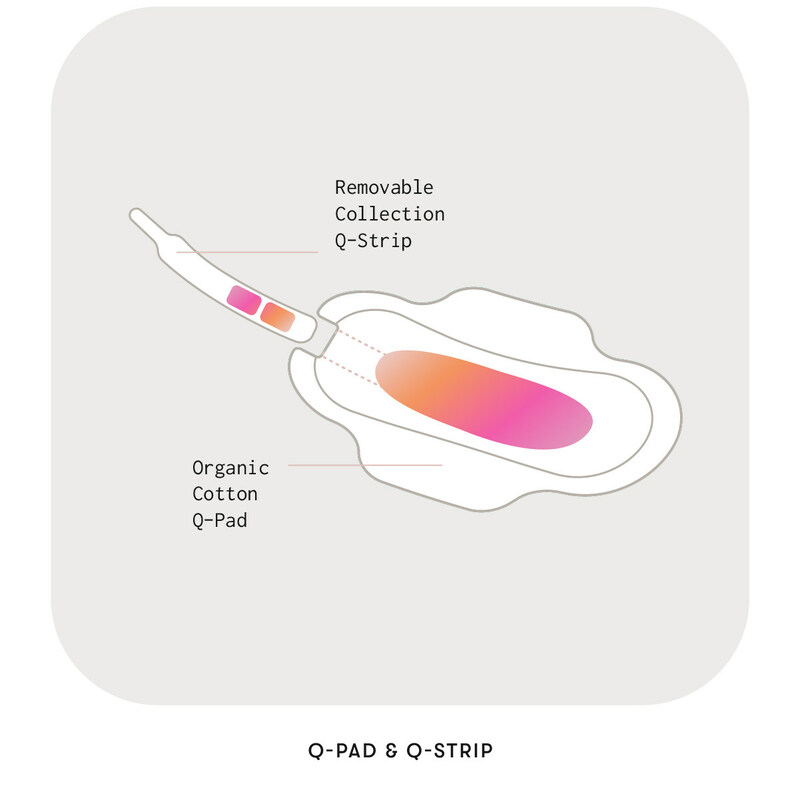Harnessing the Power of Periods For A1C Testing
By April Hopcroft
 Cleared by the FDA for over-the-counter use, the Q-Pad uses menstrual blood as a less invasive way to test blood glucose and other health markers from the convenience of home.
Cleared by the FDA for over-the-counter use, the Q-Pad uses menstrual blood as a less invasive way to test blood glucose and other health markers from the convenience of home.
For people who menstruate, monthly bleeding is often viewed as an unpleasant, painful, and even messy experience.
What if there was a way to take advantage of your period to test important biomarkers? Could menstrual fluid help women monitor their health without the hassle of visiting a doctor’s office?
Enter Q-Pad, a recently FDA-cleared product that allows users to collect menstrual blood for A1C testing.
With the Q-Pad, the women’s health startup Qvin (derived from the Danish word for woman, kvinde), wants to change the way people think about menstrual blood. Instead of something discarded into the garbage, Qvin says “menstrual blood is a superpower for women and women’s health research.”
What is the Q-Pad?
The Q-Pad is a cotton menstrual pad that contains a removable test strip, called a Q-Strip. Their A1C test kit contains two Q-Pads, which should be used on days 2-4 of your menstrual cycle, the heaviest period days.
Once the Q-Pad has collected enough menstrual fluid, remove the Q-Strip and place it in the provided storage container. Then, mail both test strips to a certified lab for analysis using the prepaid envelope.
You can view lab results via email or in the free Qvin app (App Store; Google Play). An independent board-certified physician from your state will examine and approve your results. Note that the A1C results are not meant to diagnose, treat, or prevent any disease. Be sure to consult your healthcare provider if you have questions about your A1C.
Q-Pad is available for $49 on Qvin.com.
What does research show about the Q-Pad’s diagnostic abilities?
Researchers from Stanford University tested the Q-Pad in 172 women aged 18-45 years. Nearly 60% of participants didn’t have diabetes and 42% had either type 1 or type 2 diabetes.
The study found no significant differences in average A1C levels between menstrual samples from the Q-Pad and regular blood draws.
In addition to A1C, a smaller pilot study found that cholesterol, creatinine, LDL and HDL cholesterol, triglycerides, and a protein that helps predict cardiovascular disease could all be estimated reliably via menstrual fluid.
The Q-Pad was originally developed to find biomarkers for HPV, a sexually transmitted infection that can cause different types of cancers. Studies have also investigated the Q-Pad’s ability to detect reproductive hormones and markers of inflammation.
In the future, the Q-Pad could be used to test for thyroid disease, fertility, perimenopause, endometriosis, anemia, and other conditions.
The bottom line
The Q-Pad has the potential to transform A1C monitoring by providing an alternative to standard blood tests. It’s simple, easy to use, and can be done from the comfort of your home.
For people with a fear of needles or those who have a hard time accessing labs due to cost, transportation, time constraints, and other barriers, Q-Pad could be a more streamlined way to monitor their diabetes.
Beyond improving access to A1C testing, the Q-Pad may help reduce stigma surrounding menstruation. In the same way that people with diabetes may experience stigma as a result of their condition, people who menstruate may have a negative view of their period.
By showing that menstrual blood can be a tool to understand health, rather than just a waste product, the Q-Pad may help lessen feelings of shame, fear, and disgrace about a normal bodily function.
Learn more about diabetes and women’s health here:
Image credit: Qvin







